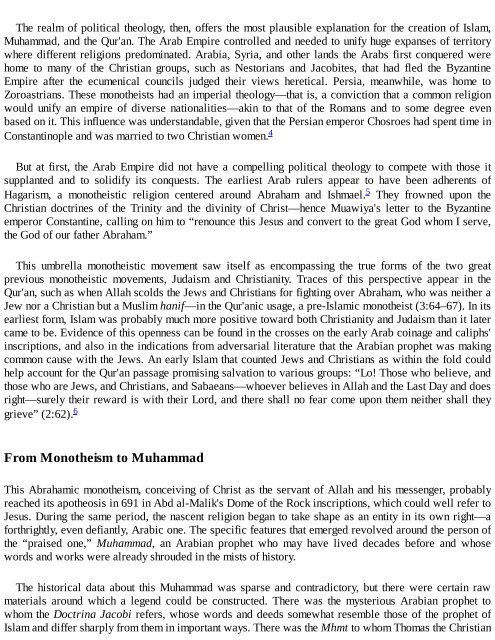robert spencer-did muhammad exist__ an inquiry into islams obscure origins-intercollegiate studies institute (2012) (1)
You also want an ePaper? Increase the reach of your titles
YUMPU automatically turns print PDFs into web optimized ePapers that Google loves.
The realm of political theology, then, offers the most plausible expl<strong>an</strong>ation for the creation of Islam,<br />
Muhammad, <strong>an</strong>d the Qur'<strong>an</strong>. The Arab Empire controlled <strong>an</strong>d needed to unify huge exp<strong>an</strong>ses of territory<br />
where different religions predominated. Arabia, Syria, <strong>an</strong>d other l<strong>an</strong>ds the Arabs first conquered were<br />
home to m<strong>an</strong>y of the Christi<strong>an</strong> groups, such as Nestori<strong>an</strong>s <strong>an</strong>d Jacobites, that had fled the Byz<strong>an</strong>tine<br />
Empire after the ecumenical councils judged their views heretical. Persia, me<strong>an</strong>while, was home to<br />
Zoroastri<strong>an</strong>s. These monotheists had <strong>an</strong> imperial theology—that is, a conviction that a common religion<br />
would unify <strong>an</strong> empire of diverse nationalities—akin to that of the Rom<strong>an</strong>s <strong>an</strong>d to some degree even<br />
based on it. This influence was underst<strong>an</strong>dable, given that the Persi<strong>an</strong> emperor Chosroes had spent time in<br />
Const<strong>an</strong>tinople <strong>an</strong>d was married to two Christi<strong>an</strong> women. 4<br />
But at first, the Arab Empire <strong>did</strong> not have a compelling political theology to compete with those it<br />
suppl<strong>an</strong>ted <strong>an</strong>d to solidify its conquests. The earliest Arab rulers appear to have been adherents of<br />
Hagarism, a monotheistic religion centered around Abraham <strong>an</strong>d Ishmael. 5 They frowned upon the<br />
Christi<strong>an</strong> doctrines of the Trinity <strong>an</strong>d the divinity of Christ—hence Muawiya's letter to the Byz<strong>an</strong>tine<br />
emperor Const<strong>an</strong>tine, calling on him to “renounce this Jesus <strong>an</strong>d convert to the great God whom I serve,<br />
the God of our father Abraham.”<br />
This umbrella monotheistic movement saw itself as encompassing the true forms of the two great<br />
previous monotheistic movements, Judaism <strong>an</strong>d Christi<strong>an</strong>ity. Traces of this perspective appear in the<br />
Qur'<strong>an</strong>, such as when Allah scolds the Jews <strong>an</strong>d Christi<strong>an</strong>s for fighting over Abraham, who was neither a<br />
Jew nor a Christi<strong>an</strong> but a Muslim h<strong>an</strong>if—in the Qur'<strong>an</strong>ic usage, a pre-Islamic monotheist (3:64–67). In its<br />
earliest form, Islam was probably much more positive toward both Christi<strong>an</strong>ity <strong>an</strong>d Judaism th<strong>an</strong> it later<br />
came to be. Evidence of this openness c<strong>an</strong> be found in the crosses on the early Arab coinage <strong>an</strong>d caliphs'<br />
inscriptions, <strong>an</strong>d also in the indications from adversarial literature that the Arabi<strong>an</strong> prophet was making<br />
common cause with the Jews. An early Islam that counted Jews <strong>an</strong>d Christi<strong>an</strong>s as within the fold could<br />
help account for the Qur'<strong>an</strong> passage promising salvation to various groups: “Lo! Those who believe, <strong>an</strong>d<br />
those who are Jews, <strong>an</strong>d Christi<strong>an</strong>s, <strong>an</strong>d Sabae<strong>an</strong>s—whoever believes in Allah <strong>an</strong>d the Last Day <strong>an</strong>d does<br />
right—surely their reward is with their Lord, <strong>an</strong>d there shall no fear come upon them neither shall they<br />
grieve” (2:62). 6<br />
From Monotheism to Muhammad<br />
This Abrahamic monotheism, conceiving of Christ as the serv<strong>an</strong>t of Allah <strong>an</strong>d his messenger, probably<br />
reached its apotheosis in 691 in Abd al-Malik's Dome of the Rock inscriptions, which could well refer to<br />
Jesus. During the same period, the nascent religion beg<strong>an</strong> to take shape as <strong>an</strong> entity in its own right—a<br />
forthrightly, even defi<strong>an</strong>tly, Arabic one. The specific features that emerged revolved around the person of<br />
the “praised one,” Muhammad, <strong>an</strong> Arabi<strong>an</strong> prophet who may have lived decades before <strong>an</strong>d whose<br />
words <strong>an</strong>d works were already shrouded in the mists of history.<br />
The historical data about this Muhammad was sparse <strong>an</strong>d contradictory, but there were certain raw<br />
materials around which a legend could be constructed. There was the mysterious Arabi<strong>an</strong> prophet to<br />
whom the Doctrina Jacobi refers, whose words <strong>an</strong>d deeds somewhat resemble those of the prophet of<br />
Islam <strong>an</strong>d differ sharply from them in import<strong>an</strong>t ways. There was the Mhmt to whom Thomas the Christi<strong>an</strong>


